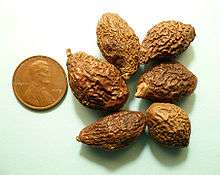Sterculia lychnophora
| Sterculia lychnophora Hance | |
|---|---|
 | |
| Dried Sterculia lychnophora seeds | |
| Scientific classification | |
| Kingdom: | Plantae |
| (unranked): | Angiosperms |
| (unranked): | Eudicots |
| (unranked): | Rosids |
| Order: | Malvales |
| Family: | Malvaceae |
| Genus: | Sterculia |
| Species: | S. lychnophora |
| Binomial name | |
| Sterculia lychnophora Hance | |
Sterculia lychnophora Hance (Malva nut tree or Taiwan sweet gum tree) is a species of tree in the genus Sterculia, native to mainland Southeast Asia. Its seed is used in traditional Chinese medicine as a "coolant", for gastrointestinal disorders, and for soothing the throat. As a result, it is collected as a major non-timber forest product in Laos, and is that country's second export crop after coffee.
Description
The tree grows to a height of 25–30 meters. The dried seeds are the size of an adult's fingertip; they are brown and have coarse skin.
The species is also given as Scaphium macropodum or Scaphium lychnophorum.
Common names for the malva nut
- Lao: ໝາກຈອງ /mȁːk cɔːŋ/
- Chinese: 胖大海; pinyin: pànɡdàhǎi; literally: "fat ocean"
- Vietnamese: hạt lười ươi; đười ươi; hột lười ươi
- Khmer: សំរោង /sɑmraoŋ marathi - naranjan phal/.
- Thai: ลูกสำรอง, หมากจอง, พุงทะลาย
- Malay: Kembang Semangkuk
Culinary and medicinal use of the nuts
Malva nuts in soups and desserts

The flesh surrounding the dried seeds swells to eight times its original volume when soaked in water, forming an irregularly shaped, reddish gelatinous mass. After being soaked and the seed kernel removed, the flesh is mixed with granulated white sugar, ice, and soaked basil seeds, and drunk as a cooling drink in Vietnam, Thailand, Laos and Cambodia. They are sometimes also used, along with other ingredients, in sweet, cool soups similar to the Chinese tong sui.
In China, malva nut is used in tea as well by mixing with other ingredients such as sugar candy, red date, haw, liquorice, chrysanthemun flower, lilyturfroot, and jasmine tea. The advantage of such tea is believed to reduce the "hotness" of the body, and nurture the body.
Malva nuts in traditional Chinese medicine
According to Chinese medicine, the use of "sterculia lychnophora," or "Pang Da Hai" is to remove heat from the lung, to cure sore throat, to counteract toxicity, and to moisten the bowels. Specific symptoms treated include: hoarseness of voice, dry cough or productive cough with yellow sticky sputum, sore, dry throat due to heat in the lung and constipation with headache and bloodshot eyes. Consume malva nut by adding one or two nuts to a large cup of boiling water and consume the liquid. Typically, in traditional Chinese medicine, malva nut would be part of a larger formula of herbs designed to address a person's condition.
Although it possesses medicinal properties, care must be taken with its consumption. Avoid boiling more than 3 seeds per drink. Overconsumption symptoms include white watery phlegm, nausea, coughing, and swollen tongue. People with frequent digestion problems and abdominal pain or diarrhea should avoid it entirely.
Sterculinine is a bio-active alkaloid found in Sterculia lychnophora.
External links
- Malva nut on the Lao NTFP wiki
- Detailed reference in the Lao NTFP network's "Tree tenure and forest management in Southern Laos" (pgs 4~14)
